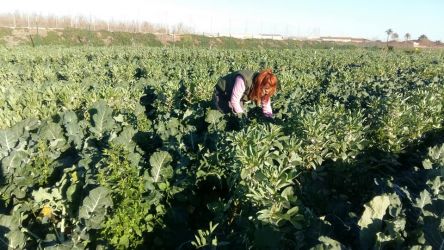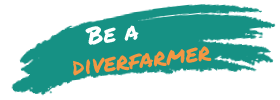Female researchers, farmers, technicians and agricultural entrepreneurs from all over Europe work for crop diversification within the Diverfarming project
Several years ago, in Mexico, Esperanza Huerta was gathering samples of worms from different agriculture systems when she met a female banana grower who, additionally, had land with diversified fruit trees. Why? The answer was simple: “because my sons and daughters don’t only eat bananas, they need other fruits and vegetables”.
 The anecdote was a turning point for Esperanza, researcher at the University of Wageningen (Netherlands), who considers the vision that women bring to agriculture as essential. Years later, Esperanza works within the Diverfarming crop diversification project financed by the European Commission, where she develops her research directly with the farm-working communities in Wageningen.
The anecdote was a turning point for Esperanza, researcher at the University of Wageningen (Netherlands), who considers the vision that women bring to agriculture as essential. Years later, Esperanza works within the Diverfarming crop diversification project financed by the European Commission, where she develops her research directly with the farm-working communities in Wageningen.
Following in the wake of the Mexican peasant who diversified her orchard to make her children’s diet more complete, now Esperanza works with a further 68 women with backgrounds as researchers, technicians, and farmers, and who comprise 47% of the Diverfarming team.
In its drive for the visibility of women and gender equality, the European project has achieved equality in both the number of women participating in the project as well as in the positions of power they occupy.
The list of women is led by Marina Giménez, the Project Manager who, from the International Projects Office at the Universidad Politécnica de Cartagena (UPCT). She controls the payments and incomes of partners and squares up the justification of the project thanks to the great doses of flexibility, polyvalence and creativity that are needed to resolve problems in a project which includes 25 institutions from eight European countries with differing idiosyncrasies and languages.
Territory leadership
Women are a majority among the territorial coordination of the project, managing four of the six regions that Diverfarming has divided the territory into. Alessandra Trinchera, researcher at the Council for Agricultural Research and Economics of the Agrarian Economy – CREA in Italy holds the reins of one of these regions, the North Mediterranean, where she acts as the nexus between the academia and the Italian companies in the consortium, namely Barilla and Casalasco. She serves as a bridge to involve both male and female farmers in the adoption of crop diversification as a solution to the problems of erosion and drops in the yield of crops that the region endures, using the different languages and the knowledge of traditions of both fields as the weapons managed on a daily basis in the development of her coordination tasks.
Having participated in over 25 national and international projects, for Alessandra “the direct contact with the farmers, who are often the source of inspiration for scientific innovation” continues to be one of the most important aspects of her work in agriculture, a sector in which she considers women as playing an “essential role due to their ability with regard to innovation and creativity and the sensitivity toward social problems”.
Although the gender balance in CREA is rather equal in the research teams as well as in the positions of power, this is not a faithful reflection of Italian society, where statistics from 2009 revealed that only 32.2% of Italian women managed the farms (Istat, 2009). Despite this inequality, some initiatives towards equality such as those which Diverfarming pursues are already bearing fruit in the Italian agricultural society: with almost two million employed in the sector, in 2017 the number of agricultural businesses run by women had increased by 6.6%. The future of Italian agriculture looks feminine.
Equality on the ground
The experimental lands in which the triad of research, farm workers, and agrobusiness is conducting trials in crop diversification also achieve 50% equality. Virginia Sánchez Navarro, 33 years of age and doctored from the UPCT, moves in this area and coordinates two case studies: case study 2 where a mandarin farm is diversified, and case study 16 where different combinations of horticultural products are tested.
She is an expert in the sustainable growing of legumes and studies soil fertility, greenhouse gas emissions, carbon sequestration and the nutritional status of the crops, and evaluates both the life in the laboratory as well as the social relationships contributed by field work.
Although Spanish agriculture remains 97.6% dominated by men (Encuesta de Población Activa, 4th quarter of 2018), Virginia highlights the work within the project of ‘women who cope perfectly well in this sector’.
Change of paradigm in the European scene
Diverfarming is conceived on the drive for the change in paradigm in European agriculture in a transition towards agriculture which is more sustainable for the environment and more efficient for farmers thanks to the use of crop diversification and low-input management practices. At the same level, it includes in its bosom a perspective of gender that seeks to give visibility to the women within a sector in which only 30% of the farms in the European Union are managed by women (Eurostat) and in which the salary gap between women with respect to men is around 16% (European Commission, 2014).
The parity within the core of the project thus becomes an example and a driver within the sector. Measures which range from the design of capacitation activities directed at women or the stimulation of the participation of female farmhands, technicians or workers in the sector in the network of ‘Communities of female and male farmers’ that the project will seek to put into practice for the crop diversification, are other tools that will be used to achieve the change in paradigm of European agriculture towards an agrarian scenario which is more feminised and sustainable.
Diverfarming is a project financed by the Horizon 2020 Programme of the European Commission, within the challenge of “Food Security, Sustainable Agriculture and Forestry, Marine, Maritime and Inland Water Research and the Bioeconomy”, which counts on the participation of the Universities of Cartagena and Córdoba (Spain), Tuscia (Italy), Exeter and Portsmouth (United Kingdom), Wageningen (Netherlands), Trier (Germany), Pecs (Hungary) and ETH Zurich (Switzerland), the research centres Consiglio per la ricerca in agricoltura e l'analisi dell'economia agraria (Italy), the Consejo Superior de Investigaciones Científicas (Spain) and the Natural Resources Institute LUKE (Finland), the agrarian organisation ASAJA, and the companies Casalasco and Barilla (Italy), Arento, Disfrimur Logística and Industrias David (Spain), Nieuw Bromo Van Tilburg and Ekoboerdeij de Lingehof (Netherlands), Weingut Dr. Frey (Germany), Nedel-Market KFT and Gere (Hungary) and Paavolan Kotijuustola and Polven Juustola (Finland)).










